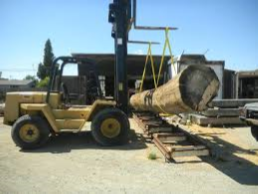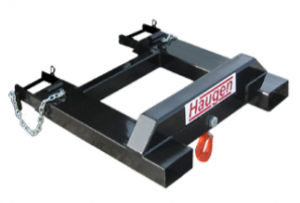It’s been said that necessity is the mother of invention. So when forklift operator’s are faced with moving a variety of unusual material they have come up with innovative ways to accomplish the task. One of these ways is what is often called free rigging.
Free rigging is the practice of attaching any of a variety of rigging  equipment (such as chains, slings, shackles, rings, etc.) directly to the forks and suspending an object below the forks.
equipment (such as chains, slings, shackles, rings, etc.) directly to the forks and suspending an object below the forks.
The problem is that free rigging, even though common, poses several hazards.
- The use of a sling, etc. can be considered to be a modification by OSHA and therefore requires the manufacturers written approval.
- Attaching chains, slings, etc. directly to the forks does not use an approved lifting attachment such as the one pictured here, which is designed to prevent the rigging from slipping off a metal fork, reduce friction from a sling rubbing against the edge of the fork, and to center the load evenly between both forks. Sometimes employees will suspend an object from only one fork which again affects the center of gravity.

- Please remember that the use of any attachments that affect the capacity or safe operation of the forklift requires a new data plate.
- A suspended load has a dynamic, and therefore unpredictable, effect on the forklifts stability, so extreme caution should always be exercised when operating with suspended loads.
Suspended loads are more prone to swinging due to the movement of the forklift, wind, etc. which can change the center of gravity of the forklift
If you would like to share your experiences/photos of forklift incidents that can educate others on the principles of safe forklift operation please send them to: bhulberg@D2000safety.com
We will not publish company or individuals names.
Newsletters may or may not open automatically, depending on the web browser settings you are using.